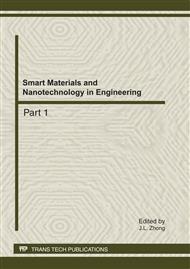[1]
Williamson R L, Rabin B H. FEM study of the effects of interlayers and creep in reducing residual stresses and strains in ceramic-metal joints. Composites Engineering, 1995, 5(7): 851-63.
DOI: 10.1016/0961-9526(95)00035-l
Google Scholar
[2]
Xiao Jinsheng, Liu Jie, etc. Research on Thermal Shock Resistance Properties of Ceramic/Metal Gradient Thermal Barrier Coating. JOURNAL OF WUHAN UNIVERSITY OF TECHNOLOGY, 2002, 24(9): 11-14.
Google Scholar
[3]
Pan Xinxiang, Yan Li, Xu Jiujun, etc. The Contact Stress Distribution Analysis for the Rough SurfaceSliding on the Gradient Layers Coating. CHINESE JOURNAL OF APPLIED MECHANICS. 2000, 17(2): 56-62.
Google Scholar
[4]
Liu Jie, Xiao Jinsheng, Qin Feng, Cui Dongzhou. Finite Difference Analysis for Heat Transfer and Thermal Stress of Ceramic/Metal Gradient Thermal Barrier Coating Cylinder. Journal of Wuhan University of Technology (Transportation Science &Engineering). 2002, 26(3): 279-382.
DOI: 10.1007/bf02835024
Google Scholar
[5]
Sumi N, Sugano Y. Thermally induced stress waves in functionally graded materials with temperature-dependent material properties. Journal of Thermal Stresses, 1997, 20(3-4): 281-94.
DOI: 10.1080/01495739708956103
Google Scholar
[6]
Huang W, Rokhlin S I. Generalized self-consistent model for composites with functionally graded and multilayered interphases. Transfer matrix approach. Mechanics of Materials, 1996, 22(3): 219-247.
DOI: 10.1016/0167-6636(95)00032-1
Google Scholar
[7]
Bao G, Wang L. Multiple cracking in functionally graded ceramic/metal coatings. International Journal of Solids and Structures, 1995, 32 (19): 2853-2871.
DOI: 10.1016/0020-7683(94)00267-z
Google Scholar
[8]
Jiang C P. A generalized self-consistent method for piezoelectric fiber reinforced composites under antiplane shear. Mechanics of Materials, 2001, 33(5): 295-308.
DOI: 10.1016/s0167-6636(00)00062-4
Google Scholar
[9]
Hori M, Nemat-Nasser S. Double-inclusion model and overall moduli of multi-phase composites. Transactions of the ASME. Journal of Engineering Materials and Technology, 1994, 116(3): 305-309.
DOI: 10.1115/1.2904292
Google Scholar
[10]
Cheng Hong-mei, Cao Zhi-yuan. Microelement method for 3-d analysis of functionally graded plates with complex boundary conditions. engineering mechanics, 2006, 23(12): 19-24.
Google Scholar
[11]
Shen H S. Bending, buckling and vibration of functionally graded composite material plates and shells [J]. Advances in Mechanics, 2004, 34(1): 53-60.
Google Scholar


